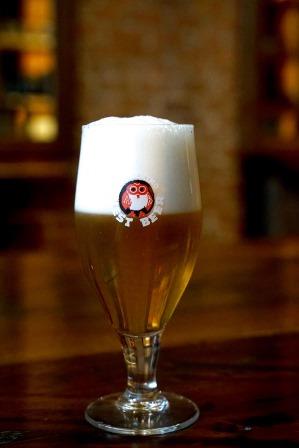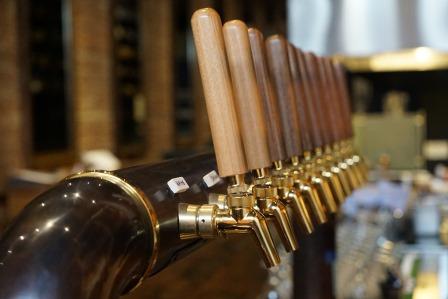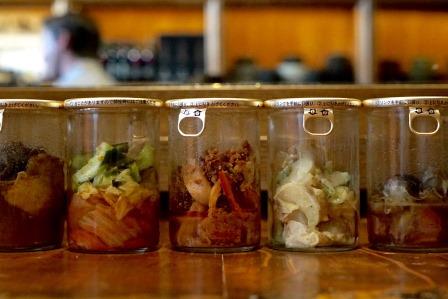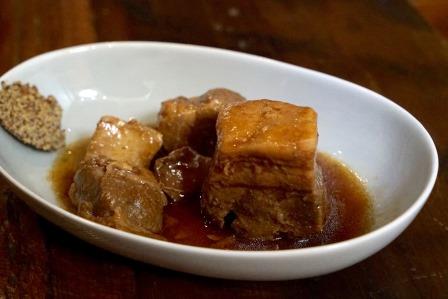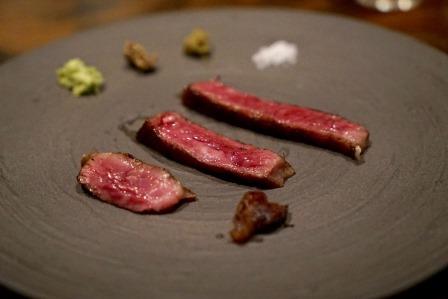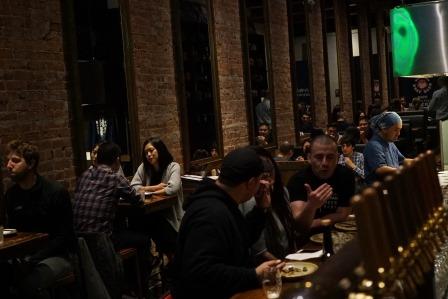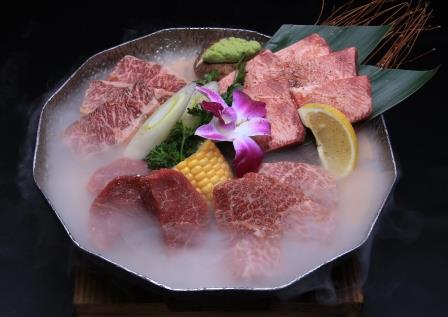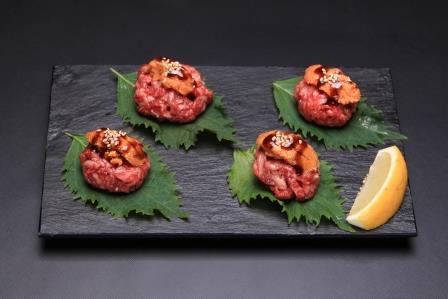The first US “Hitachino Beer” restaurant, born in Ibaraki prefecture, opens! The quality and brand power are pursued.
By Elli Sekine
“Hitachino Nest Beer”, known by its red owl logo, is gaining popularity in the US. The number of fans of this premium craft beer is growing, especially among foodies. The “Red Owl Phenomenon” seems to be appearing wildly in and out of the metropolitan areas of the US cities. For example, at “Whole Foods”, one of the specialty store chains, the space for the colorful owls (various kinds of the owl brand beer) has constantly been increasing each year, and in New York, you see its unique delivery trucks all over the city. The “Hitachino Nest Beer”, which was born in a small brewery in the Ibaraki prefecture, has now become one of the leading Japanese craft beer brands. Subsequently, this spring, the first US captive restaurant, “Hitachino Beer + Wagyu” opened in the downtown area of San Francisco. It is an exclusive restaurant where you can enjoy the first directly-imported Japanese draft beer, which has been long-awaited by many Nest Beer fans, along with the Hitachino brand wagyu.
The “Hitachino Nest Beer” is made by “Kiuchi Brewery”, a brewery with over 200 years of history in Hitachino city. There, a traditional way of saké making has been carried over multiple generations, and they still make saké. However, as years go by, saké making has been decreasing every year in Japan, and currently, there are only about 1,200 breweries compared to 3,500 in 1962 (by National Tax Agency).
A seventh generation sake-maker of Kiuchi Brewery, Toshiyuki Kiuchi, the Senior Executive of Kiuch Brewery Company, suggested to take on a brand-new beer brewing business to survive in the industry by taking advantage of the craft beer boom happening at that time. The “Hitachino Nest Beer” was thus born in 1996. The craft beer boom died down in two years, but Kiuchi Brewery survived. Not only did they survive, they started to expand to the rest of the world. “We were making beer anyway, so we wanted to make the kind of beer that can be accepted world-wide,” said Mr. Kiuchi, reminiscing. They were so determined.
They hired a beer brewing specialist from the US, and succeeded to earn the “World Beer Cup” title within 2 years from the start of the sales in 1998. They have been looking 10, 20 years ahead since, and strengthening the overseas export business. Now, 20 years since the start of the sales, Mr. Kiuchi’s strategy for overseas has worked out well. The beer branch has been separated from the saké branch of the company as “Kiuchi Brewery N”, and the beer factory in Ibaraki prefecture has been expanded for the production. About 50% of the whole production is exported, and half of it is for the US. New York accounts for the majority of the sales in the US.
However, why was San Francisco chosen for the first restaurant? “In the whole US, they have the biggest foodie population, and their gourmet related information will spread worldwide with no time,” says Mr. Kiuchi. Compared to New York, the California market has only a 15% share, and is still under developed. He said that he did not think twice about choosing this location in order to strengthen the brand power. To prove it right, as soon as the red owl sign got illuminated in downtown, many people gathered right away. Most of the crowd were young Hitachino Beer fans. They looked happy, drinking the draft beer from the 10 different kinds of taps.
There is a large counter by the entrance of the restaurant, and the interior decorated with the furniture which used to be used at Ibaraki’s Kiuchi Brewery has created a serene Japanese ambience. The pub area is around the counter, and the dining area is in the back with tables for relaxed eating. The menu for the two areas are different. For the counter bar, you can choose and take small dishes in a cup (a glass cup as you see in any Japanese vending machine) filled with nikujaga, kakuni, salad, pickles, etc. to your plate to eat. On the other hand, the restaurant space is for reservations only. Hitachino brand wagyu is imported directly, and a wagyu course meal is served.
The executive chef is Noriyuki Sugie, who is also from Hitachino. He is known for his skillful collaboration of Japanese and western cuisine popups in San Francisco. He met Hitachino Beer while he was working at the Mandarin Hotel in New York, and has been doing beer collaborations with Kiuchi Brewery all over the word. The unique course meal using Hitachino brand Wagyu A5 attracts customers with its long-learned international cooking technique with a Japanese twist. The taste of the Japan-produced beef is wonderful, and the price is reasonable.
“Hitachino Nest Beer” keeps moving at high speed from the Ibaraki prefecture to the world, and never seems to stop. In 2014, they built the first overseas large beer factory in South Korea to expand their overseas markets. Whereas in Japan, they opened Hitachino Brewing Labs where anyone can experience craft beer brewing, in Kanda, Tokyo, etc. to establish a new craft beer era. Its rapid growth must be due to their passion for beer making which is particular about using pure Japanese produce (most of it is made in Ibaraki in the efforts to contribute to hometown revitalization), and the branding strategy. I feel proud of Kiuchi Brewery who has demonstrated a real example as to how to have Japanese craft beer be recognized by the world.
茨城県から生まれた「常陸野ビール」レストラン米国一号店がオープン!クオリティーとブランド力を追求する
赤いフクロウのロゴでお馴染みの「常陸野ネストビール」が米国で人気急上昇中だ。特にフーディーの間ではプレミアムクラフトとして愛飲者が増えている。すでに「ホールフーズ」等のスペシャリティーストアでは、年々棚一列に色とりどりのフクロウ(数種類のビール)がその幅を拡張しており、ニューヨークではこの専用輸送トラックが街を走り回るほど、“赤いフクロウ現象”が米国都市部を中心に吹き荒れている。いまやジャパニーズクラフトビールの代表格となったのが、茨城県の小さな酒蔵から生まれた「常陸野ネストビール」なのだ。そしてこの春、全米に先駆け直営第一号店となるレストラン、「Hitachino Beer+Wagyu」がサンフランシスコ、ダウンタウンにオープンした。“ネストビール”ファンが待ちわびた、米国で初めて日本直輸入のドラフトビールと常陸野ブランドの和牛が楽しめるエクスクルーシブな店だ。
常陸野ネストビールの醸造元は、茨城県、常陸野市で200年以上の歴史を持つ蔵元、「木内酒造」。ここでは代々伝統的な酒造りを継承し、今でも日本酒造りが続けられている。しかし時代の流れと共に、国内では日本酒の消費が年々減り続け、1962年に3,500蔵あったとされる酒蔵も現在では約1,200蔵に減少している。
(日本国税局調べ)その現状を重く受け止めた7代目、木内酒造取締役の木内俊之氏は、当時の地ビールブームを後ろ盾に生き残りをかけて新規ビール醸造事業を考案。そして1996年に生まれたのが、「常陸野ネストビール」だ。ブームは2年後には衰退したが、木内酒造は行き残った。それどころか世界進出を始めたのだ。その時のことを、「どうせ作るなら世界に通用するビールを作りたかった」と木内氏は振り返る。本格的にビール醸造専門家を米国から雇用し、1998年の販売開始から約2年で米国「ワールドビアカップ」でタイトル獲得にまで漕ぎつけた。そこから10年後、20年後を見据え海外輸出を強化した。そして現在がその20年後になるのだが、木本氏の海外戦略は見事に成功している。ビール事業は酒事業と分業され、「木内酒造合弁会社N」とし、茨城県のビール工場を拡張して生産されている。
海外輸出はその内約50%、その半分が米国輸出となっている。米国での販売数はニューヨークが圧倒的に多い。しかしなぜ第一号店はサンフランシスコだったのか。「全米の中で最もフーディーな人口が多く、ここからのグルメ情報はあっという間に世界に広がる」と木内氏。NYと比べるとまだカリフォルニア市場は17%の普及途上にある。ブランド力を高める為、ロケーションに迷いはなかったという。その期待に応えるように、ダウンタウンに赤いフクロウの看板が点灯されると、たちまち多くの人が訪れた。客の大半は若年層の“ネストビール” ファン達。彼らは初めて口にする直輸入のタップ10種類を飲み比べならが楽しんでいた。
店内は入り口には大きなカウンターが設置され、茨城県の「木内酒造」で使用していた家具を設置し、和の情緖を醸し出している。カウンター周りがパブ部門で、奥にはテーブルでゆっくり食事ができるダイニングに分かれる。メニューは異なり、カウンターではユニークなワンカップ(日本の自販機で見られるガラスカップ)に入った肉じゃがや角煮、サラダ、漬物などのつまみが中心だが、最近アラカルトの注文もできるようになった。一方、レストランは予約優先で、和牛も常陸野ブランドを直輸入し、「和牛コース料理」を提供している。
エグゼキュティブシェフには、同じく常陸野出身の杉江のりゆき氏が務める。
彼はサンフランシスコでは和と洋をコラボさせた匠な料理のポップアップでその名を知られている。NYのマンダリンオリエンタルホテルでシェフを勤めていた際常陸野ビールと出会い、木内酒造とこれまで世界各国でビールコラボを続けてきた。独特の常陸野ブランドA 5和牛を使ったコース料理は、繊細な味付けと巧みな食材の組み合わせ。今まで培った国際的な料理のテクニックに和のツイストを加えて客を魅了している。価格設定($78 〜)もリーズナブル。
茨城県から世界に快進撃を続ける「常陸野ネストビール」はとどまるところを知らない。
2014年には韓国に海外発の大規模なビール工場を設立し海外販路を広げている。一方国内では、だれでもクラフト醸造の体験ができる「常陸野ブルーイング・ラボ」を神田や東京にオープンし、新しいクラフトビール時代を築いている。その急成長は、純国産(殆は茨城県産でふるさとの活性化に貢献している)にこだわったビール作りの情熱とブランディング戦略の賜物でろう。日本産クラフトビールが世界に認めらる実例を作った「木内酒造」という小さな酒蔵が創る純国産クラフトビールが、世界に認められた実証がここにある。
Hitachino Beer and Wagyu
639 Post St, San Francisco, CA 94109
(415) 792-6160
http://www.hitachinosf.com/
Tuesday - Saturday 4:30PM–12AM
“Hitachino Nest Beer”, known by its red owl logo, is gaining popularity in the US. The number of fans of this premium craft beer is growing, especially among foodies. The “Red Owl Phenomenon” seems to be appearing wildly in and out of the metropolitan areas of the US cities. For example, at “Whole Foods”, one of the specialty store chains, the space for the colorful owls (various kinds of the owl brand beer) has constantly been increasing each year, and in New York, you see its unique delivery trucks all over the city. The “Hitachino Nest Beer”, which was born in a small brewery in the Ibaraki prefecture, has now become one of the leading Japanese craft beer brands. Subsequently, this spring, the first US captive restaurant, “Hitachino Beer + Wagyu” opened in the downtown area of San Francisco. It is an exclusive restaurant where you can enjoy the first directly-imported Japanese draft beer, which has been long-awaited by many Nest Beer fans, along with the Hitachino brand wagyu.
The “Hitachino Nest Beer” is made by “Kiuchi Brewery”, a brewery with over 200 years of history in Hitachino city. There, a traditional way of saké making has been carried over multiple generations, and they still make saké. However, as years go by, saké making has been decreasing every year in Japan, and currently, there are only about 1,200 breweries compared to 3,500 in 1962 (by National Tax Agency).
A seventh generation sake-maker of Kiuchi Brewery, Toshiyuki Kiuchi, the Senior Executive of Kiuch Brewery Company, suggested to take on a brand-new beer brewing business to survive in the industry by taking advantage of the craft beer boom happening at that time. The “Hitachino Nest Beer” was thus born in 1996. The craft beer boom died down in two years, but Kiuchi Brewery survived. Not only did they survive, they started to expand to the rest of the world. “We were making beer anyway, so we wanted to make the kind of beer that can be accepted world-wide,” said Mr. Kiuchi, reminiscing. They were so determined.
They hired a beer brewing specialist from the US, and succeeded to earn the “World Beer Cup” title within 2 years from the start of the sales in 1998. They have been looking 10, 20 years ahead since, and strengthening the overseas export business. Now, 20 years since the start of the sales, Mr. Kiuchi’s strategy for overseas has worked out well. The beer branch has been separated from the saké branch of the company as “Kiuchi Brewery N”, and the beer factory in Ibaraki prefecture has been expanded for the production. About 50% of the whole production is exported, and half of it is for the US. New York accounts for the majority of the sales in the US.
However, why was San Francisco chosen for the first restaurant? “In the whole US, they have the biggest foodie population, and their gourmet related information will spread worldwide with no time,” says Mr. Kiuchi. Compared to New York, the California market has only a 15% share, and is still under developed. He said that he did not think twice about choosing this location in order to strengthen the brand power. To prove it right, as soon as the red owl sign got illuminated in downtown, many people gathered right away. Most of the crowd were young Hitachino Beer fans. They looked happy, drinking the draft beer from the 10 different kinds of taps.
There is a large counter by the entrance of the restaurant, and the interior decorated with the furniture which used to be used at Ibaraki’s Kiuchi Brewery has created a serene Japanese ambience. The pub area is around the counter, and the dining area is in the back with tables for relaxed eating. The menu for the two areas are different. For the counter bar, you can choose and take small dishes in a cup (a glass cup as you see in any Japanese vending machine) filled with nikujaga, kakuni, salad, pickles, etc. to your plate to eat. On the other hand, the restaurant space is for reservations only. Hitachino brand wagyu is imported directly, and a wagyu course meal is served.
The executive chef is Noriyuki Sugie, who is also from Hitachino. He is known for his skillful collaboration of Japanese and western cuisine popups in San Francisco. He met Hitachino Beer while he was working at the Mandarin Hotel in New York, and has been doing beer collaborations with Kiuchi Brewery all over the word. The unique course meal using Hitachino brand Wagyu A5 attracts customers with its long-learned international cooking technique with a Japanese twist. The taste of the Japan-produced beef is wonderful, and the price is reasonable.
“Hitachino Nest Beer” keeps moving at high speed from the Ibaraki prefecture to the world, and never seems to stop. In 2014, they built the first overseas large beer factory in South Korea to expand their overseas markets. Whereas in Japan, they opened Hitachino Brewing Labs where anyone can experience craft beer brewing, in Kanda, Tokyo, etc. to establish a new craft beer era. Its rapid growth must be due to their passion for beer making which is particular about using pure Japanese produce (most of it is made in Ibaraki in the efforts to contribute to hometown revitalization), and the branding strategy. I feel proud of Kiuchi Brewery who has demonstrated a real example as to how to have Japanese craft beer be recognized by the world.
茨城県から生まれた「常陸野ビール」レストラン米国一号店がオープン!クオリティーとブランド力を追求する
赤いフクロウのロゴでお馴染みの「常陸野ネストビール」が米国で人気急上昇中だ。特にフーディーの間ではプレミアムクラフトとして愛飲者が増えている。すでに「ホールフーズ」等のスペシャリティーストアでは、年々棚一列に色とりどりのフクロウ(数種類のビール)がその幅を拡張しており、ニューヨークではこの専用輸送トラックが街を走り回るほど、“赤いフクロウ現象”が米国都市部を中心に吹き荒れている。いまやジャパニーズクラフトビールの代表格となったのが、茨城県の小さな酒蔵から生まれた「常陸野ネストビール」なのだ。そしてこの春、全米に先駆け直営第一号店となるレストラン、「Hitachino Beer+Wagyu」がサンフランシスコ、ダウンタウンにオープンした。“ネストビール”ファンが待ちわびた、米国で初めて日本直輸入のドラフトビールと常陸野ブランドの和牛が楽しめるエクスクルーシブな店だ。
常陸野ネストビールの醸造元は、茨城県、常陸野市で200年以上の歴史を持つ蔵元、「木内酒造」。ここでは代々伝統的な酒造りを継承し、今でも日本酒造りが続けられている。しかし時代の流れと共に、国内では日本酒の消費が年々減り続け、1962年に3,500蔵あったとされる酒蔵も現在では約1,200蔵に減少している。
(日本国税局調べ)その現状を重く受け止めた7代目、木内酒造取締役の木内俊之氏は、当時の地ビールブームを後ろ盾に生き残りをかけて新規ビール醸造事業を考案。そして1996年に生まれたのが、「常陸野ネストビール」だ。ブームは2年後には衰退したが、木内酒造は行き残った。それどころか世界進出を始めたのだ。その時のことを、「どうせ作るなら世界に通用するビールを作りたかった」と木内氏は振り返る。本格的にビール醸造専門家を米国から雇用し、1998年の販売開始から約2年で米国「ワールドビアカップ」でタイトル獲得にまで漕ぎつけた。そこから10年後、20年後を見据え海外輸出を強化した。そして現在がその20年後になるのだが、木本氏の海外戦略は見事に成功している。ビール事業は酒事業と分業され、「木内酒造合弁会社N」とし、茨城県のビール工場を拡張して生産されている。
海外輸出はその内約50%、その半分が米国輸出となっている。米国での販売数はニューヨークが圧倒的に多い。しかしなぜ第一号店はサンフランシスコだったのか。「全米の中で最もフーディーな人口が多く、ここからのグルメ情報はあっという間に世界に広がる」と木内氏。NYと比べるとまだカリフォルニア市場は17%の普及途上にある。ブランド力を高める為、ロケーションに迷いはなかったという。その期待に応えるように、ダウンタウンに赤いフクロウの看板が点灯されると、たちまち多くの人が訪れた。客の大半は若年層の“ネストビール” ファン達。彼らは初めて口にする直輸入のタップ10種類を飲み比べならが楽しんでいた。
店内は入り口には大きなカウンターが設置され、茨城県の「木内酒造」で使用していた家具を設置し、和の情緖を醸し出している。カウンター周りがパブ部門で、奥にはテーブルでゆっくり食事ができるダイニングに分かれる。メニューは異なり、カウンターではユニークなワンカップ(日本の自販機で見られるガラスカップ)に入った肉じゃがや角煮、サラダ、漬物などのつまみが中心だが、最近アラカルトの注文もできるようになった。一方、レストランは予約優先で、和牛も常陸野ブランドを直輸入し、「和牛コース料理」を提供している。
エグゼキュティブシェフには、同じく常陸野出身の杉江のりゆき氏が務める。
彼はサンフランシスコでは和と洋をコラボさせた匠な料理のポップアップでその名を知られている。NYのマンダリンオリエンタルホテルでシェフを勤めていた際常陸野ビールと出会い、木内酒造とこれまで世界各国でビールコラボを続けてきた。独特の常陸野ブランドA 5和牛を使ったコース料理は、繊細な味付けと巧みな食材の組み合わせ。今まで培った国際的な料理のテクニックに和のツイストを加えて客を魅了している。価格設定($78 〜)もリーズナブル。
茨城県から世界に快進撃を続ける「常陸野ネストビール」はとどまるところを知らない。
2014年には韓国に海外発の大規模なビール工場を設立し海外販路を広げている。一方国内では、だれでもクラフト醸造の体験ができる「常陸野ブルーイング・ラボ」を神田や東京にオープンし、新しいクラフトビール時代を築いている。その急成長は、純国産(殆は茨城県産でふるさとの活性化に貢献している)にこだわったビール作りの情熱とブランディング戦略の賜物でろう。日本産クラフトビールが世界に認めらる実例を作った「木内酒造」という小さな酒蔵が創る純国産クラフトビールが、世界に認められた実証がここにある。
Hitachino Beer and Wagyu
639 Post St, San Francisco, CA 94109
(415) 792-6160
http://www.hitachinosf.com/
Tuesday - Saturday 4:30PM–12AM







